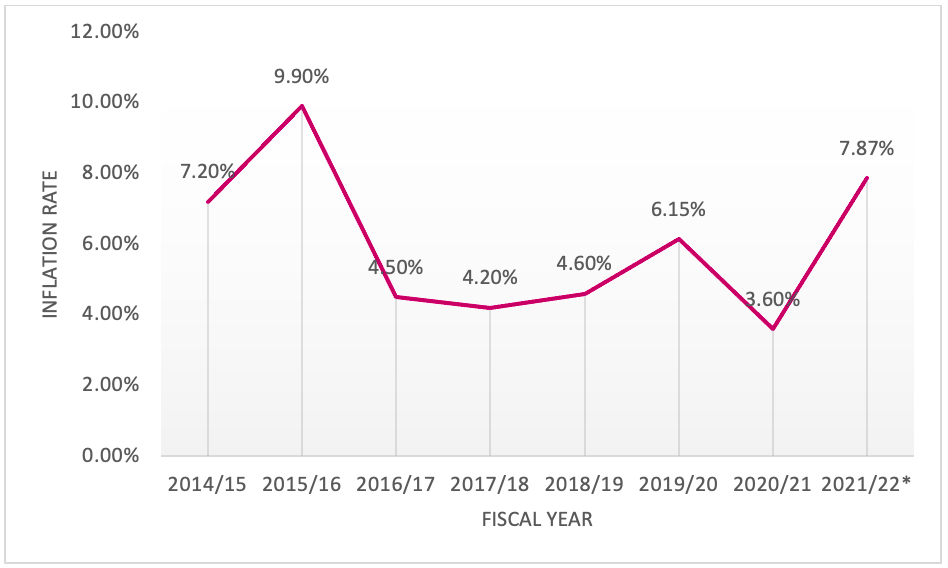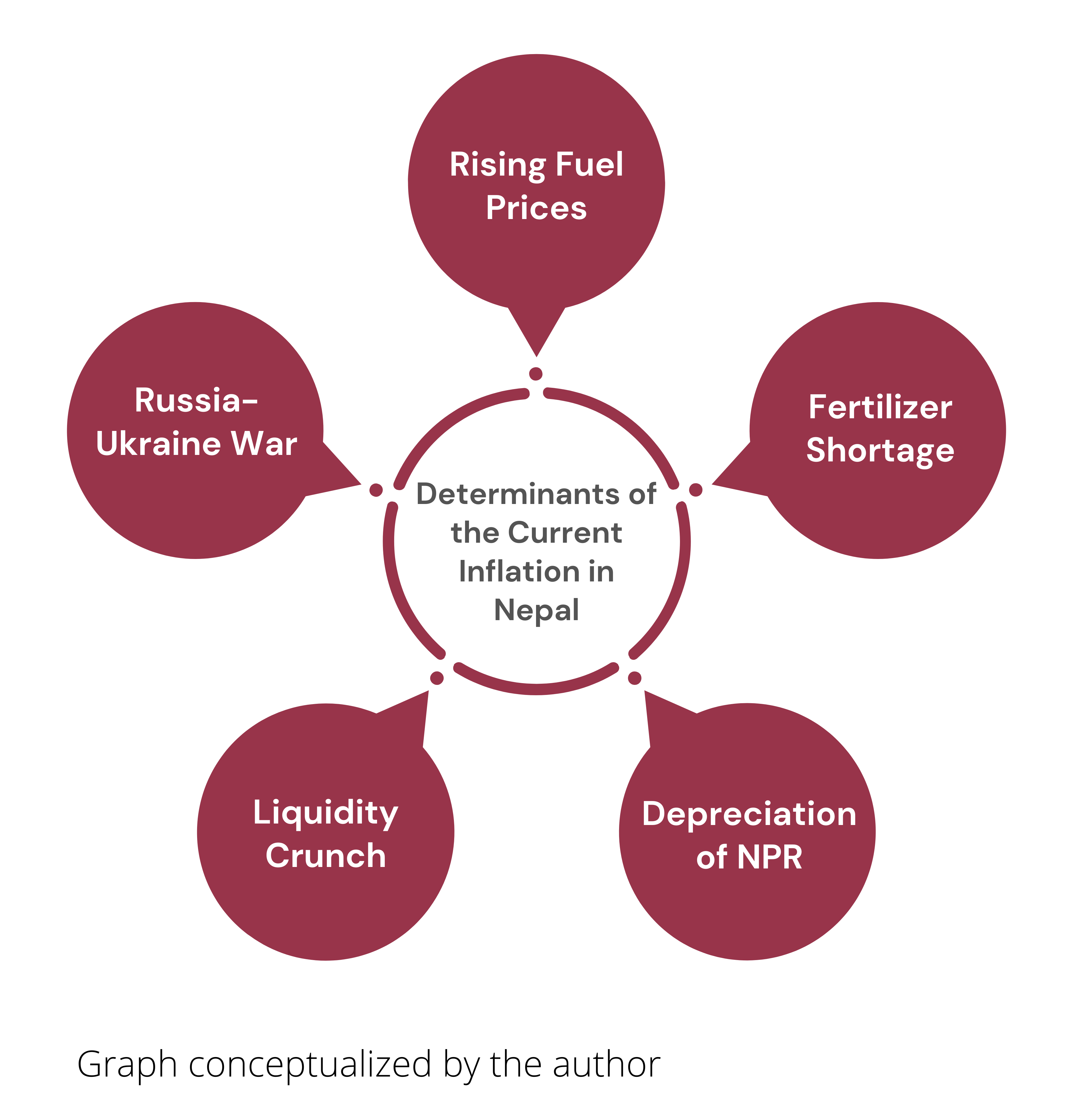While the world economy is still recuperating from the COVID-19 pandemic, the conflict in Ukraine has derailed the global economy, driving up the cost of food and other essentials. A situation of this nature has furthered the pressure on existing global inflationary pressures. According to the World Economic Situation and Prospects, as of mid-2022, global inflation is projected to reach 6.7% in 2022, which is twice the 2.9% average seen between 2010 and 2020.
The latest Current Macroeconomic and Financial Situation Report, published by the Nepal Rastra Bank highlighted that the inflation in Nepal has reached 7.87% in the first 10 months of the current fiscal year (FY) 2021/22. This has resulted in a six-year high. Inflation in the first 10 months of the FY for food and beverages stood at 7.13 %, compared to 8.45% for non-food and services. As per the report, prices of edible oil and ghee went up by almost 25%, while the price of fruits, milk products and eggs, pulses, and tobacco products increased by 12.61 %, 11.30 %, 10.53 %, and 9.70 %, respectively, on a year-on-year basis. Similarly, the price of transportation increased by over 21%, and education by 11.64% on a y-o-y basis, under the non-food and services category. The following figure shows the annual rate of inflation over the past seven years.
Figure 1. Annual Inflation Rate

Source: Nepal Rastra Bank
Determinants of the current inflation in Nepal
Figure 2. Determinants of the current inflation in Nepal

- Rising fuel prices: Fuel prices in Nepal and around the world witnessed drastic surges since the outbreak of COVID-19. Nepal saw the prices of petrol, diesel and LPG rise by 43%, 57% and 14%, respectively since the beginning of 2022. As a result, transportation costs have skyrocketed, subsequently increasing the cost of industrial production, food products and other essential items to all-time highs.
- Russia-Ukraine war: The effects of the Russia-Ukraine war on the world have also had an impact on Nepal, adding new challenges to the country’s already struggling economy. Energy, food, and commodity prices have increased as a direct result of the conflict’s disruption of exports of crude oil, natural gas, cereals, fertilizer, and metals. The Russian Federation and Ukraine are major exporters of agricultural products, contributing 25% of the world’s wheat exports, 16% of its corn exports, and 56% of its sunflower oil exports.
- Depreciation of NPR: With the US dollar trading for NPR 126.05 as of June 30, 2022, the value of the USD has reached a new historical high in Nepal. The Indian rupee, which the Nepali rupees is pegged to, has also devalued drastically since the conflict between Russia and Ukraine. For this reason, Nepali importers, who are already paying high prices for importing goods due to the increasing value of the USD, would have to pay higher amounts if the dollar keeps appreciating further. Given that Nepal imports the majority of its necessities, including food, medicine, and fuel – the strengthening of the USD would not only result in a wider Balance of Payment but would further raise the cost of goods.
- Liquidity crunch: Since the economy in Nepal began to grow after the lockdowns caused by COVID-19 were eased, the liquidity crisis became worse. The commercial banks in Nepal have been facing issues in keeping the credit-deposit (CD) ratio below 90% due to the delayed deposit collections. Officials from the NRB claim that the CD ratio at a few banks is still close to 95%. In attempts to attract deposits, banks have been increasing their interest rates. Increased interest rates translate into higher borrowing costs. This raises the cost of manufacturing for domestic industries, which in turn drives up the market price of the goods they supply.
- Fertilizer shortage: Every year, around the time of the rice sowing period, Nepal experiences a scarcity of urea fertilizers. Over 90% of the farmers, according to the National Federation of Farmers, were unable to obtain any fertilizer. According to the Ministry of Agriculture and Livestock Development, there are roughly 600,000 tons of fertilizer needed annually. According to official data from the Government of Nepal, the cost of fertilizers has increased four to five times in the past year. NPR 15 billion was allocated by the government for the import of chemical fertilizer. However, the amount would only be enough to purchase about 200,000 tons, at the present pricing. The harvest for the season could decline further due to a severe fertilizer deficit during the busiest harvesting period, reducing revenues and heightening concerns about a food scarcity and rising inflation.
Repercussions
Rising inflation, which disproportionately affects low-income households, who spend a larger percentage of their income on food, presents a bigger challenge to an inclusive recovery. The decline in real earnings is most pronounced in least developed countries like Nepal. This is because poverty is more evident on the most vulnerable people, as wage growth is still restrained, and fiscal support measures to mitigate the impact of rising food and fuel prices are more constrained. Consequently, rising food inflation would worsen food insecurity and push more people below the poverty line while Nepal continues to navigate around the impacts of the pandemic. According to the 2016 Nepal Demographic and Health Survey, 4.6 million people in Nepal were still food insecure as of January 31, 2017, with 20% of families experiencing mild to moderate food insecurity, 22% experiencing moderate to severe food insecurity, and 10% experiencing severe food insecurity. These numbers might further surge due to the rising inflation.
Additionally, NRB statistics indicate that paddy and rice imports have been rising annually. In the first eleven months of the current fiscal year (2021/22), Nepal imported grains, rice, and paddy worth NPR 45.28 billion, the majority of which came from India. A number of nations, including India, have begun enforcing export limits on food grains as a result of rising prices. India, which has already halted the export of wheat and sugar, is likely to do the same with rice and paddy, which might result in a food crisis in Nepal. Furthermore, shortages of essential food items would also increase black market activities, requiring the general public to pay more for goods.
Way forward
The budget for the upcoming fiscal year 2022/2023, includes a national initiative by the Government of Nepal to attain self-reliance in agricultural output with the goal of reducing imports of essential agricultural goods by 30%. However, given the current scenario, such import policies could result in an uneven market supply if steps are not taken to improve domestic production. Experts recommend targeted social protection programs including cash transfers for the deprived, the opening of fair price stores, and a temporary reduction in import levies on critical foods as a way to deal with the current price shocks. Fuel is a crucial factor that affects the entire consumer pricing due to its impact on supply chains. Hence the high taxes on petroleum items need to be reconsidered. By encouraging more electricity use, oil imports can be reduced, but for this to happen, people must have reliable access to electricity at affordable prices. Government policy measures that aim to boost agricultural and industrial output also need to be formulated and implemented right away. Similarly, effective market inspections need to be carried out to ensure moderate pricing and restrain artificial price increases or black market activities.
Sugam Nanda Bajracharya is an MBA graduate from Stamford International University. Currently, he is working as a Beed at Beed management and a Research Associate at Nepal Economic Forum. Sugam works actively with the private sector and development partners on topics related to trade, sectoral studies, economic policy research, policy and strategy development.





